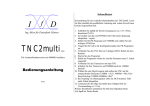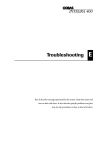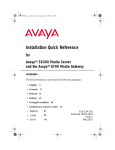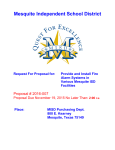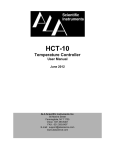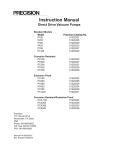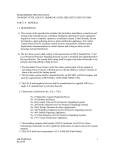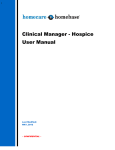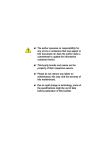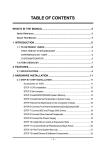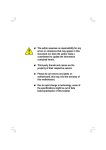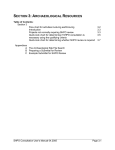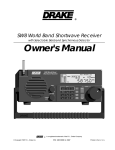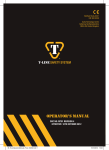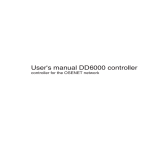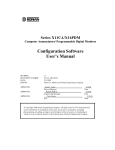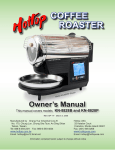Download Stand-Alone 2021 - LAUDA-Noah
Transcript
Thermoelectric Temperature Control Unit Model 2021 User Manual Copyright 1995 Noah Precision, Inc. Noah Precision, Inc. 6389 San Ignacio Avenue San Jose, CA 95119 Publication 060-00703 Rev. B November 1997 This publication is subject to replacement by a later edition. To determine whether a later edition exists, or to request copies of publications, contact Noah Precision, Inc 6389 San Ignacio Avenue San Jose, CA 95119 Telephone: 408-281-7772 FAX: 408-281-7797 All rights reserved on this document. No part may be reproduced in any form or by any means or used to make any derivative work (such as translation, transformation, or adaptation) without permission from Noah Precision. This document is provided without warranty of any kind, either implied or expressed, including, but not limited to, the implied warranties of merchantability and fitness for a particular purpose. Noah Precision may make improvements or changes in the product(s) or program(s) described in this documentation at any time. Lexan is a registered trademark of General Electric. Molex is a registered trademark of Molex Company. Teflon is a registered trademark of DuPont. Contents 1 Overview Operating Principles Controller Interface Description Displays Lockout-Tagout 1-1 1-3 1-4 1-7 1-9 2 Installation Hook-up Hook-up Procedure 2-1 2-2 System Start-up User Setup Factory Setup Com-Link Start-up RS422 Interface 2-4 2-6 2-15 2-20 2-22 System Shut-down 2-22 3 Operation Turning the System ON Process Operation Controller Keys Modes of Operation AutoTune Tuning the PID Controller 3-1 3-2 3-4 3-6 3-7 3-8 Turning the System OFF 3-14 iii 4 Alarms Types of Alarms Alarm Descriptions Information Only Alarms Output Deactivation Alarms Master Relay Alarms 4-2 4-4 4-5 4-9 4-15 5 Optional Equipment Remote Display Digital Flow Meter Liquid Pressure By-Pass Option Communication Interface 10 mV/ ˚C Communications Interface 100 mV/ ˚C Communications Interface 10 mV/ ˚C Analog Interface Special RS-422 Communication Interface 5-1 5-2 5-3 5-5 5-5 5-6 5-9 5-10 6 Troubleshooting LEDs Master Relay Safety Switches Fuses Standard Temperature Inputs Open Collector Transistor Inputs System Outputs Back Door AutoTuning Troubleshooting Guide 6-1 6-2 6-3 6-3 6-4 6-4 6-6 6-6 6-7 7 Maintenance Process Fluid Pump/Motor 7-2 7-2 iv Model 2021 Appendices A B C D E F G Engineering Specifications for the Model 2021 Model 2021 Major Components Engineering Specifications for the 962-JG Controller Process Plumbing Electrical Circuitry Circuit Markings on the 962-JG Board Acronyms Figures 1-1 1-2 1-3 1-4 1-5 1-6 1-7 1-8 1-9 1-10 Peltier Effect The 962-JG Controller Interface Model 2021 Major Components of the Model 2021 Initial Factory Display Example IDLE Mode Display Example ACTIVE Mode Display Heater Fuse Alarm Display Cleared Heater Fuse Alarm Display 2021 Lockout-Tagout Feature 1-2 1-3 1-5 1-6 1-7 1-8 1-8 1-8 1-8 1-9 2-1 2-2 2-3 2-4 2-5 Back View of the Model 2021 Model 2021 Reservoir Location of Power Switch Controller Interface Fill Monitor 3-Level Switch Displays 2-2 2-3 2-5 2-6 2-14 3-1 3-2 3-3 3-4 3-5 3-6 3-7 3-8 Circulation of Process Fluid Controller Key Locations Temperature Oscillations Oscillation Time Final Temperature Deviation Nomogram I Nomogram II Nomogram III 3-2 3-3 3-10 3-11 3-11 3-12 3-13 3-13 4-1 962-JG DIP Switch 4-9 v Figures (con't) 5-1 5-2 5-3 5-2 5-4 5-5 5-6 Remote Port Liquid Pressure By-Pass 10 mV/ ˚C Analog Signal Communication Port 100 mV/ ˚C Analog Signal Communication Port Transistor Output RS422 Communication Port D-1 D-2 D-3 Liquid Pressure By-Pass Option Facility Plumbing Process Plumbing D-1 D-2 D-3 E-1 E-2 E-3 E-4 E-5 E-6 E-7 E-8 E-9 E-10 Electrical Panel Layout Output Wiring EMO Circuit Wiring Solenoid/flow Facility Wiring 2021 Wiring DC Output Wiring RS-422 Interface Wiring 962-LE Circuit Wiring Remote Display Wiring Diagram RS422 Board E-3 & 4 E-5 & 6 E-7 E-8 E-9 E-10 E-11 E-12 E-13 E-14 5-4 5-6 5-8 5-9 5-12 Tables 2-1 2-2 User Setup Parameters Factory Setup Parameters 2-8 2-16 4-1 4-2 4-3 Information Only Alarms Output Deactivation Alarms Master Relay Alarms 4-3 4-3 4-4 vi Preface Manual Objectives This manual describes the installation, operation and maintenance of the Model 2021 Temperature Control Unit. Intended Audience The user should be familiar with basic electronics and safety procedures and guidelines. This manual is written for those who must install, operate and maintain the Model 2021 Temperature Control Unit. This audience includes support technicians, manufacturing, QA, and field service. Manual Organization Section 1 Overview Presents an overview of the thermoelectric control unit. Explains operating principles and identifies major components. Describes the user interface and provides examples of display messages. Section 2 Installation Provides step by step instructions for physical hook-up, controller setup and programming, system start-up, and communication linkages. Also explains shut-down procedures. vii Section 3 Operation Explains how to turn the system on, process operation, operation modes including all controller key functions, and how to turn the system off. Sectin 4 Alarms Describes various alarm conditions and the ramifications of each alarm. Provides detailed instructions for clearing and silencing individual alarms. Section 5 Optional Equipment Describesoptionalequipmentavailableforspecialprocessrequirements. Section 6 Troubleshooting Discusses problems that might occur with the Model 2021. Also contains a troubleshooting guide for easy reference. Section 7 Maintenance Explains preventive maintenance procedures. Provides time tables for changing coolant and moving parts. Appendix A Engineering Specifications for the Model 2021 Specifies sizes, ranges and capacities for the Model 2021 including precautions. Appendix B Model 2021 Major Components Lists major components by description and part number. Appendix C Engineering Specifications for the 962-JG Controller Describes the specifications for the Model 2021 user interface. Appendix D Process Plumbing viii Model 2021 Diagrams the process plumbing flow. Appendix E Electrical Circuitry Provides schematics of the electrical panel and controller circuitry including EMO circuitry. Appendix F Circuit Markings on the 962-JG Board Explains board layout and markings including switches and contacts. Appendix G Acronyms Lists the acronyms used throughout the manual. Related Documents RS422 Communication Supplement (Part Number 060-00704) ix Safeguards This manual contains certain information labeled with danger, warning and caution messages. Read all information highlighted in this manner carefully. Danger Danger High Voltage A Danger message alerts the user of a possibility of a fatal injury. For example, high voltage. Warning A Warning message alerts the user of a possibility of serious injury. Caution A Caution message alerts the user of a possibility of equipment damage. Note A Note alerts the user of the possibility of minor complications. Operate the Model 2021 only with the type of power source indicated on the marking label (208 VAC, 60 Hz, 3-phase Delta, 30 amp). An Emergency Machine Off (EMO) button is provided on the front of the controller interface. x Model 2021 Limited Warranty Noah Precision warrants its products against defects in materials and workmanship under normal use and service for the period of warranty from the date of delivery. If a product does not operate as warranted during the warranty period, Noah Precision shall, at its expense, correct any such defect by repairing the defective product or part or, at its option, by delivering to the customer an equivalent product or part to replace the defective item. All products that are replaced become the property of Noah Precision. Replacement products may be new or reconditioned. Any replaced or repaired product or part is guaranteed for the remainder of the initial warranty period. Noah Precision shall not be liable under this warranty if its testing and examination disclose that the alleged defect in the product does not exist or was caused by the customer’s or any third person’s misuse, neglect, improper installation or testing, unauthorized attempts to repair, or any other cause beyond the range of the intended use, or by accident, fire, lightning, or other hazard. Limitation of Liability: In no event, shall Noah Precision be liable for incidental, consequential, indirect, special, or punitive damages of any kind, or for loss of revenue, loss of business, or other financial loss arising out of or in connection with the sale, installation, maintenance, use, performance, failure, or interruption of its products, even if Noah Precision or its authorized reseller has been advised of the possibility of such damages. xi Registration All Noah Precision products include the model number and the serial number on the nameplate. This nameplate is found on back plate of the unit adjacent to the power cord. NOAH PRECISION, INC. MODEL SERIAL ____ VAC ____ Amp ____ Phase ____ Wire ____ Hz 6389 San Ignacio Avenue, San Jose, CA 95119 Please use the information from the nameplate to complete and return the registration card immediately Unpacking and Damage Noah Precision, Inc. inspects each product thoroughly before packaging. Safe delivery is the responsibility of the carrier. Please inspect the unit for damage and submit claims for loss or damage to the carrier itself. Visible damage should be noted on the freight bill. Be sure the carrier’s agent signs the freight bill acknowledging the damage. The carrier has the required forms for submitting damage claims. Crates are reusable. Please do not destroy. Warning Heavy load. Unit weighs 170 lbs. xii Model 2021 NOAH PRECIS ION, NOAH INC. PRECIS ION, INC. NOAH PRECISI ON, INC. NO AH NO AH PR EC PR ISI EC ON ISI , IN ON C. NO , IN AH C. PR EC ISI ON , IN C. When unpacking, do NOT turn crates on their sides. 1. Unscrew the bolts at the bottom of the crate. 2. Remove the top assembly. 3. Unscrew the bolts on the side of the Temperature Control Unit (TCU). Caution Do NOT lift by the parts that protrude from the back of the unit. If there are damages that are not apparent until after unpacking the unit, file a written request for inspection by the carrier’s agent at once. There is usually a fifteen (15) day time limit for concealed damage claims. Contact Noah Precision to receive a Return Material Authorization (RMA) BEFORE returning the unit to the factory. Save all packaging materials and be sure to include all name plate data including part number and serial number when communicating with the Noah Precision factory. xiii xiv 1 Overview The Model 2021 Temperature Control Unit (TCU) incorporates solid state thermoelectric technology which completely eliminates the use of Ozone Depleting Chemicals (ODCs) or toxic Freon substitutes. Specifically developed for semiconductor wafer processing equipment, its small footprint makes it ideal for cleanroom applications. Designed and tested for reliable, efficient and quiet operation, the Model 2021 requires minimal maintenance and service to provide a continuous supply of cooling fluid at a constant temperature. It comes equipped with pump, controller, power supply unit and cooling reservoir. Operating Principles The Model 2021 operates on the principle of thermoelectric cooling based on the Peltier Effect. Thermoelectric (TE) devices are small solid-state heat pumps. Their advantages include small space requirements and high reliability. A single-stage thermoelectric cooling unit is a matrix of thermoelectric couples, connected in series electrically, and connected in parallel thermally. The number of couples depends on the cooling requirement. 1-1 1 Overview Each couple consists of p -type and n -type semiconductor pillars positioned between two ceramic plates. These plates provide a rigid mounting structure and electrical insulation between the heat sink and the process being cooled. Cooling capacity is proportional to the supply current and the number of couples. Peltier discovered that heat is released or absorbed when two dissimilar materials that conduct electrical current are joined. A positive voltage applied to the n -type material drives electrons from the p -type to the n-type material and back to the voltage supply. The temperature on the cold side decreases as heat is absorbed. The heat is then conducted through the couple to the hot side to dissipate through a heat sink. The heat dissipated is the sum of the heat removed from the cold side and the heat generated by the thermoelectric input power. Reversing the voltage polarity changes the hot side of the couple to the cold side. Heat absorbed from device being cooled Tc (Cold side) p Type n Type (Heat dissipated to Heat Sink) V Th (Hot side) (Current) DC source Figure 1 - 1 Peltier Effect The applications of this principle to thermoelectric cooling enables the temperature control unit to cool process fluids and maintain required temperatures with high reliability and low maintenance. 1-2 Model 2021 Controller Interface A microprocessor based controller, Model 962-JG, is the user interface and control for the Model 2021 cooling system. It monitors temperature with a J-type thermocouple sensor or an RTD sensor depending on the application. An RTD sensor is more commonly used. The control loop is a standard three mode Proportional Integral Derivative control algorithm (PID control scheme) with anti-reset windup. The 962-JG employs an autotune routine to determine three mode control parameters: Proportional band, Reset and Rate. Status, alarm and diagnostic functions are monitored and reported through both an audio buzzer and a 2 x 20 backlighted LCD display. The LCD also displays set-up parameters. A six-key tactile keypad provides for set-up data and user adjustments. A short beep acknowledges valid inputs and a razz tone sounds if the input is invalid. See Figure 1-2. Two additional LEDs on the face panel indicate the immediate status of the heating and cooling outputs. The audio buzzer also sounds if an alarm message appears. NOAH PRECISION, INC. START STOP ALARM SILENCE UP DOWN MODE RETURN M HEAT Figure 1 - 2 COOL The 962-JG Controller Interface There are two circuit assemblies: the main board (located inside the system) and the display panel (962 controller interface). The main controller card is interconnected via a flat ribbon cable to the face panel that has the display, keypad and audio. 1-3 1 Overview The 962-JG has six optically isolated solid state relay (SSR) outputs and twelve optically isolated user inputs. The master relay is controlled by the microprocessor but can also be turned off with four independent thermal snap switch inputs or by the Thermocouple High Limit input. The redundant high limit temperature circuit uses a Type-J thermocouple sensor. Totally independent of the main microprocessor circuit, it has its own optional independent power supply. The Model 2021 has a two-stage cooling routine. Each stage consists of one bank of thermoelectric modules, totaling two banks of modules. The 962-JG controller calculates how many stages of thermoelectrics need to be activated at a given time. If the setpoint is considerably lower than the actual temperature, all banks go on with the proper stage delay until the temperature reaches the setpoint. The heater then cycles on and off to counteract the cooling. The controller calculates exactly how much cooling is needed. If the heater is on at least 88% of the time, it turns off a cooling stage. If the heater is on less than 12% and is above the setpoint, a cooling stage is added. The controller calculates the most efficient operating stage for a particular setpoint, thus minimizing overall energy consumption. Description The Model 2021 incorporates the following features: • State-of-the-art microprocessor temperature controller • Solid state thermoelectric cooling module • High pressure turbine pump • Independent DC power supply Measuring just 31 inches long by 14 inches wide by 27 inches high, the Model 2021 provides continuous cooling with minimal space requirements. See Figure 1-3 for a frontal view of the Model 2021. 1-4 Model 2021 NOA H PRE CIS ION , INC . 27" NO AH PR EC ISIO N, IN C. 31 " 14" Figure 1 - 3 Model 2021 Constructed with a steel chassis, stainless steel cooling reservoirs and Buna-N plumbing, the Model 2021’s tank capacity is 4.5 gallons. Temperature range is 0 ˚C to 90 ˚C. The six-key tactile keypad located on the front panel allows user adjustments and system set-up. Directly below the message display window, two LEDs show the current status of the heating and cooling outputs. Two 2000 watt immersion heating modules are mounted on top of the tank. 1-5 1 Overview The power supply is a direct AC rectified to DC. Figure 1-4 provides a diagram of major components. Unit specifications are listed in Appendix A and component parts are itemized by part number in Appendix B. Appendix C has the engineering specifications for the 962-JG controller. Thermoelectric Module Snap-tite plug 3-float liquid level sensor 2000 watt heater (2) Bleed resistors RTD probe EMO Diode bridges D.I. Cartridges Solid state relays 1/2 HP motor Fuses 4.5 gallon 316 Stainless steel tank 30A main contactor Pump 962-JG controller 962-LG communication board Drain valve Resistivity box Circuit breaker Figure 1 - 4 Major Components of the Model 2021 1-6 Model 2021 Displays All programming and informational messages are displayed in the window on the front of the controller panel. There are four types of display messages: set-up, status, alarm and diagnostic messages. Each message contains two lines. The first line of the display indicates the general mode of the system. The upper left corner indicates one of the five basic system control modes: ACTIVE, IDLE, ALARM, SETUP and AUTOTUNE. The upper right corner displays the temperature of the process water Out. The second line displays the current setpoint of the system, the current resistivity value, or the current flow value. These options are selected by the UP and DOWN keys. A special scanning option causes these values to rotate continuously at a time interval programmed by the user. The only time the display lines do not read this way is when the system is first turned on and the initial display from the factory appears. The factory screen identifies the model number of the system. This message lasts about 7 seconds while the system initializes and runs a complete battery of self-diagnostics. See Figure 1-5. NOAH PRECISION MODEL 2021 Figure 1 - 5 Initial Factory Display 1-7 1 Overview IDLE MODE 25.5 C SETPOINT 35.5 C When the system has completed its diagnostics, the screen changes to read IDLE Mode and the setpoint. Figure 1-6 is an example of an IDLE Mode screen. Figure 1 - 6 Example IDLE Mode Display When the Start Key is pressed, the screen displays ACTIVE Mode, the temperature of the process water Out, and the setpoint. The ACTIVE Mode display remains until the user enters another function or an alarm condition occurs. See Figure 1-7. ACTIVE MODE 35.0 C SETPOINT 35.0 C Figure 1 - 7 Example ACTIVE Mode Display In case of an alarm, the top line of the display indicates the type of alarm. The second line indicates the status of the alarm. Figure1-8 is an example of an active heater fuse alarm. HEATER FUSE (ACTIVE) Figure 1 - 8 Heater Fuse Alarm Display 1-8 Model 2021 When an alarm has been cleared, the alarm display changes to indicate the cleared status. See Figure 1-9. HEATER FUSE (CLEARED) Figure 1 - 9 Cleared Heater Fuse Alarm Display A cleared alarm screen remains until the user presses the Start Key. The display changes to ACTIVE Mode. If six seconds elapse before the Start Key is pressed, the system goes into IDLE Mode. Lockout-Tagout The Model 2020g incorporates a Lockout-Tagout safety feature to protect individuals during maintenance or service. When the system is turned off, a lock is inserted in the frame of the machine over the circuit breaker to prevent accidental power up. See Figure 1-10. A lockout tag shows who locked the system along with time and date. NO AH PR EC ISI ON , INC . DA NG EQ LOCK UIPMEN ED O T UT BY ER DEPT. TIME: DATE: Figure 1 - 10 Model 2021 Lockout-Tagout Feature 1-9 1 Overview 1 - 10 2 Installation Installing the Model 2021 takes about 30 minutes* including Hook-up, System start-up and Com-link start. The only items required are basic plumbing tools, deionized water/ethylene glycol and a power source. AUTOTUNE requires an additional 15 to 60 minutes to execute. Hook-up Before beginning the installation, test the facility supply water. • ≤ 20 µm filtered water • Flow rate: minimum 3 gpm • Temperature range:+10 to +25 ˚C • Water pressure:50 to 80 psi with minimum differential pressure of 30 psi. Refer to Figure 2-1 on the following page for a back view of the Model 2021 and hook-up procedures. * Assuming plumbing for both process and facility water are already in place. 2-1 2 Installation 25-Pin Remote Process IN 9-Pin Process OUT Facilities IN Facilities OUT Figure 2 - 1 Back View of the Model 2021 Hook-up procedure 1. Check the DI cartridges. Tighten until snug (hand tight). 2. Connect the tubing for the Process IN fluid. Use 1/2 inch diameter tubing or equivalent. Located above the deionization cartridge. The Process IN is the return line of the TCU. Process fluid from the etcher/CVD goes to the TCU. 3. Connect the tubing for the Process OUT fluid. Use 1/2 inch diameter tubing or equivalent. Located to the right of the power cord plug. The Process OUT is the supply line of the TCU. Process fluid from the TCU goes to the etcher/CVD machine. 2-2 Model 2021 4. Connect the Facility IN port. Use 1/2 inch NPT tubing. Located next to the Process OUT port. 5. Connect the Facility OUT port. Use 1/2 inch NPT tubing. Located on the right side of the back of the unit. 6. Remove the left side panel of the Model 2021. Verify that the drain valve is off by checking that the yellow covered lever is in a horizontal position. This is located at the bottom of the the tank. Refer to Figure 2-2. NOA H PRE CIS ION , INC . NO AH PR EC ISIO N, Figure 2 - 2 7. IN C. Model 2021 Reservoir Lock the front two casters. Warning For earthquake safety, the unit must be bolted on to the ground. 2-3 2 Installation 8. Connect the power cord. Service must be 208 VAC, 30 amp, 5 wire. Check the power distribution for proper phases. x = A phase, y = B phase, z = C phase, w= neutral, g = ground 9. Connect the communication port. Reattach the left side panel and hook-up is complete. The tank is filled during the start-up procedure. System Start-up Before activating the Model 2021, check that the EMO button (located on the left side of the controller front panel) is protruding. If pressed in, twist clockwise to reset. The start-up procedure includes • User Setup • Factory Setup • Correct filling procedures for the cooling tank • Temperature calibration All start-up functions are programmed through the controller. From the side panel circuit breaker, turn the power switch to ON. See Figure 2-3. The thermoelectric module, heater element and pump motor are automatically reset to the Off (idle) state when the system is powered up. 2-4 Model 2021 NOA H PRE CIS ION , INC . NO AH PR EC ISIO N, Figure 2 - 3 IN C. Location of Power Switch The factory model number appears on the controller display for approximately seven seconds while the unit initializes and executes a set of self-diagnostics. NOAH PRECISION MODEL 2021 2-5 2 Installation When diagnostics are complete, the screen displays the current IDLE Mode and Setpoint. IDLE MODE xxC SETPOINT xxC If the display does not respond, check that the 9-pin circular connector at the back of the unit is plugged in correctly. If the display still fails to respond, refer to Section 6 Troubleshooting. Refer to Figure 2-4 for the location of keys on the controller interface to program the unit. NOAH PRECISION, INC. START STOP ALARM SILENCE UP DOWN MODE RETURN M HEAT Figure 2 - 4 COOL Controller Interface User Setup 2-6 Model 2021 Press the MODE key to enter the User Setup parameters. The display responds with a message to enter a user access code. This is initially set to 01 at the factory. ENTER ACCESS CODE XXXX Use the UP and DOWN keys to enter a four digit code. Then press the MODE key again to continue programming user parameters. (If a user code is not required, simply press the MODE key a second time without using the UP and DOWN keys.) The following display appears: SETUP USER SETPOINT XXX.XC The second line of this screen begins a series of parameters that must be set or adjusted for individual use. Use the MODE key to advance through the various parameters. Use the UP and DOWN keys to change the settings. Pressing and releasing the key 2-7 2 Installation immediately changes the setting of the least significant digit, pressing and holding the key down increments values automatically and rapidly. To exit the SET-UP Mode, press the RETURN key. Table 2-1 lists the screen displays for the User Setup, the parameters associated with the display, the range allowed within each parameter, and the factory programmed value. Descriptions of each parameter follow. Table 2 - 1 User Setup Parameters Display Parameter Range SETPOINT Process setpoint 0.0 to max deg C T/C -5.0 to max deg RTD varies LOC SETPOINT Local process setpoint* 0.0 to max deg C T/C -5.0 to max deg RTD varies REM SETPOINT Remote process setpoint* 0.0 to max deg C T/C -5.0 to max deg RTD varies HIGH TEMP High temp. setpoint 0.0 to max deg C T/C -5.0 to max deg RTD 42.5 ˚C HIGH DEV ALARM High deviation alarm* 0.0 to 9.9 ˚C 5.0 ˚C LOW TEMP Low temp. setpoint 0.0 to max deg C T/C -5.0 to max deg RTD 9.0 ˚C LOW DEV ALARM Low deviation alarm* 0.0 to 9.9 ˚C 5.0 ˚C LOW RESIST Low resistivity setpoint 0.00 to 18.18 mohm 1.50M LOW FLOW Low flow setpoint 0.0 to 20.0 gpm STAGE DELAY CYCLE RATE PROP BAND RESET RATE Stage delay Cycle rate Proportional band Reset (integral) Rate (derivative) 0 to 250 seconds 1 to 25 seconds 0.0 to 25.0 deg C 0.0 to 25.0 minutes 0.0 to 25.0 minutes 2-8 Factory Values 0.0 gpm 60 sec 05 sec 1.2 ˚C 1.7' 0.9' Model 2021 Display Parameter Range 2ND HEATER SENSOR CALI SYSTEM ID BAUD RATE ACCESS CODE AUTO TUNE SCAN TIME FILLMONITOR*** Second heater Sensor calibration System ID number Baud rate Access code Auto tune Scan time Fill monitor display On/Off +/- 9.9 deg C 00 to 99 300 to 19,200 0 to 9999 On/Off 0 to 5 seconds On/Off Factory Values Off varies 9600 01 Off 03 sec Off * 100 mV/ ˚C machines only ** The temperature deviation setpoint must be programmed to activate at 2.5 degrees below the process setpoint. *** This parameter must be ON when filling the cooling tank. Refer to the parameter descriptions on the next page for detailed instructions. User Setup Parameters SETPOINT This is the Process Setpoint for the system. It is the target temperature for the three mode PID algorithm. LOC SETPOINT (if applicable) This parameter is the Process setpoint for 100mV/ ˚C machines in local mode. REMOTE SETPOINT (if applicable) This parameter is the Process setpoint for 100mV/ ˚C machines in remote mode. Once the temperature is programmed with this parameter, the temperature is controlled by the process chamber via a 24 VAC signal to the 2021 TCU. If the 24 volt signal is active, the process temperature is controlled by the Remote setpoint. If the 24 volt signal is inactive, the process temperature is controlled by the 2-9 2 Installation Local setpoint. (This parameter excludes the need to change the program setting of the RS232 parameter in the Factory Setup.) HIGH TEMP This is the High temperature alarm setpoint. The Process temperature is continually compared with this setting. If exceeded, the High Temperature alarm is activated. (To eliminate this alarm, set the respective setpoint to its lowest obtainable value. This value depends on the SENSOR selection. For the T/C sensor, the value is 0.0 ˚C; for the RTD sensor, -25.0 ˚C.) HIGH DEV ALARM (if applicable) This parameter changes the High temperature alarm setpoint from a direct setpoint to a relative setpoint. The High temp alarm will activate when the process temperature exceeds the process setpoint plus the High deviation alarm setpoint. For example, if the High dev alarm is set at 5 ˚C and the Process temperature is set at 18.0 ˚C, and the ACTIVE Mode temperature is above 23.0 ˚C, the High process temp alarm activates. LOW TEMP This is the Low temperature alarm setpoint. If the Process temperature falls below this setting after warmup, the Low Temperature alarm is activated. LOW DEV ALARM(if applicable) This parameter changes the Low temperature alarm setpoint from a direct setpoint to a relative setpoint. The Low temp alarm will activate when the process temperature falls below the process setpoint minus the Low deviation alarm setpoint. For example, if the Low dev alarm is set at 5 ˚C and the Process temperature is set 2 - 10 Model 2021 at 18.0 ˚C, and the ACTIVE Mode temperature is below 13.0 ˚C, the Low process temp alarm activates. LOW RESIST This is the Low resistivity alarm setpoint. If Resistivity is activated in Factory Setup, this value is continuously compared with the Resistivity input. If the Resistivity input falls below this level for 10 seconds, a Low Resistivity alarm appears. LOW FLOW This is the Low flow alarm setpoint. If Flow is activated in Factory Setup, this value is continuously compared with inputs from the 962-L. If the flow falls below this level for 10 seconds, a Low Flow alarm is activated. STAGE DELAY This is the Stage delay time interval, the time between adding or removing stages of cooling. If heater output is operating above 88% output, cooling stages are disabled at the Stage delay interval. If heater output is operating at below 12% output, cooling stages are enabled at the Stage delay interval. This is set at 60 seconds at the factory. A shorter time results in a faster response (switching of the thermoelectrics) but is not stable. CYCLE RATE This parameter sets the Cycle rate for the system. Because the controller is a standard proportional time base unit, the Cycle rate sets the rate at which the heat output cycles on and off. The amount of time the output is on during each period is controlled to match the heat requirements of the system. PROP BAND 2 - 11 2 Installation The Proportional band parameter determines the cycling range for the controller in degrees Celsius. This is the P parameter (Proportional). RESET The Reset parameter sets the integration time for the second mode in the three mode control scheme. Setting this parameter to 0.0, eliminates the reset function. This is the I parameter (Integral). RATE The Rate parameter sets the differentiation constant for the third mode of the three mode control scheme. Setting this parameter to 0.0, eliminates the rate function. This is the D parameter (Derivative). 2ND HEATER This parameter eliminates or activates the second heater output. When activated, the heater turns on when the temperature setpoint is set to ≥ 40 ˚C. SENSOR CALI This is the digital calibration for the Process sensor and a direct digital offset to the Process temperature. To calibrate, place a thermometer or temperature calibrator in the tank. Measure the value, then adjust the calibration using the UP and DOWN keys. Press the RETURN key to save. Repeat these steps until the Process temperature matches the temperature on the thermometer. Remember to press RETURN to save. Note 2 - 12 Model 2021 The 2021 is temperature calibrated when shipped from the factory. The USER MUST RECALIBRATE the temperature at the facility to verify the number settings. SYSTEM ID NUMBER Used with the communications protocol, the number identifies each unit in a system configuration that uses multiple controllers. BAUD RATE This parameter sets the Baud rate for the communications protocol (300, 600, 1200, 2400, 4800, 9600,19200). Default is 9600 baud. ACCESS CODE This Access code must be matched to enter the USER Setup parameters. If this parameter is set to zero, no access code is required. AUTO TUNE This parameter activates the AUTOTUNE mode. If set to On, the system automatically begins the AUTOTUNE routine the first time the system enters ACTIVE Mode. AUTOTUNE adjusts the PID parameters for optimal process results. The words AUTOTUNE flash during the AUTOTUNE routine. During this procedure, the system runs a test sequence to determine basic system characteristics. Appropriate tuning values 2 - 13 2 Installation are calculated and automatically inserted into the PROP BAND, RESET and RATE parameters. Note The system is tuned to 18 ˚C before leaving the factory. For better process control, Noah Precision recommends that the user use the Autotune parameter at its specific operating process temperature. SCAN TIME The second line of the ACTIVE Mode display can be set to display alternately current flow and resistivity values. The display time of each value is set with this parameter. FILL MONITOR This parameter activates the Fill Monitor mode to allow for precise filling of the cooling tank or reservoir. Press the UP key. The top line of the display reads FILL MONITOR and the second line shows the level of the reservoir fluid. At the initial start-up and when fluid levels are low, the following screen appears. FILL MONITOR ADD FLUID The level is sensed by a 3-level switch wired to the LLT, LLR and SP5 input. If the fluid level is below full, the lower display line reads 2 - 14 Model 2021 ADD FLUID. When the reservoir is full, the display changes to FULL. A full tank is sensed by a closed switch at the LLR input. Figure 2-5 shows the displays activated by the 3-level switch. FILL MONITOR ADD FLUID Figure 2 - 5 FILL MONITOR NEEDS FLUID ADDED FILL MONITOR FULL Fill Monitor 3-Level Switch Displays To add fluid, open the small hinged door located on the top center of the unit. Unscrew the small (2 inch diameter) stainless steel plug. Do NOT use anti-freeze automotive liquid. Warning Ethylene glycol is a hazardous chemical. Dispose of properly. Reservoir capacity is 4.5 gallons not including external plumbing and DI cartridge containers. Fill until the water is visible to the bottom of the lid coupling (approximately 1 3/8 inches from the top). A special razz tone sounds when the tank is full. Put the plug back and close the lid. Check for leaks. Press the RETURN key to save and the DOWN key to exit the Fill Monitor mode. Save to go back to the ACTIVE or IDLE Mode display, or to exit User Setup. Press the RETURN key to exit the SETUP Mode. The system is now in the ACTIVE Mode. During warmup, unless the Process temperature exceeds the Low alarm setpoint, the alarm is not activated. This feature eliminates nuisance alarms during start-up. 2 - 15 2 Installation Factory Set-up Press the MODE Key to enter the Factory Setup Mode. If access code protection is required, enter a second access code using the UP and DOWN keys to enter a four digit code. ENTER ACCESS CODE 2 XXXX Press the MODE key a second time to view or program factory parameters. (If an access code is unnecessary, simply press the MODE key the second time without using the UP and DOWN keys.) If the access code matches, the following screen appears: SETUP - FACTORY MAXIMUM SETPOINT The second line of this screen shows the first of a series of factory parameters. Use the MODE key to advance through the parameters. Use the UP and DOWN keys to adjust settings. To exit the Factory Setup, press the RETURN key. Table 2-2 lists the screen displays for the Factory Setup parameters, the parameters associated with each display, and the range allowed within each parameter. Descriptions of each parameter follow. These parameters are set at the factory to configure the system to specific equipment. Caution Changing a Factory Setup parameter can require a complete system reconfiguration. 2 - 16 Model 2021 CALL Noah Precision before changing a parameter if uncertain of the results. Table 2 - 2 Factory Setup Parameters Display Parameter Range MAX SETPOINT Maximum setpoint -10.0 to 90.0 ˚C RTD COOLING Cooling Active Yes/No RESISTIVITY Resistivity Active Yes/No FLOW ACTIVE Flow option Active Yes/No SENSOR TYPE Process sensory type T/C or RTD RS232 ACTIVE RS232 Active 0= NO RS232 1= Normal RS232 2= PS* Write only 3= Flow Write only 4= PS&Flow write only MODEL DISPLAY Noah Model number 2021 SOFTWARE Current software rev XXXX ACCESS CODE#2 Access code #2 0-9999 * PS = Process setpoint Factory Setup Parameters MAX SETPOINT This parameter restricts the maximum setting ranges for all of the temperature parameters in the user setup parameters. COOLING This parameter activates or deactivates the system cooling feature. If set to NO, the cooling outputs become inactive. RESISTIVITY ACTIVE 2 - 17 2 Installation Note This parameter activates or deactivates the Resistivity reading option. If set to YES, the unit relays information from the Resistivity monitor to the proper controller displays. FLOW ACTIVE This parameter activates or deactivates the Flow reading option. If set to YES, the unit relays information from the 962-L to the proper controller displays. SENSOR TYPE This parameter identifies the type of sensor (T/C to RTD) used as the Process sensor. This setting MUST BE COORDINATED with DIP switch settings on the 962J board. For correct DIP switch settings, refer to Figure 4-1. When changing sensor type, all other temperature setpoint values must be changed. There is a 25 degree offset between the RTD and T/C sensor types because of the temperature ranges obtainable by the different sensors. RTD is standard on the Model 2021. RS232 ACTIVE This parameter activates or deactivates the RS232 communications function. Settings: 0 = removes the SYSTEM ID NUMBER and BAUD RATE parameters 2 - 18 Model 2021 1 = activates all functions of the RS232 2 = the WRITE command is restricted to the Process setpoint parameter 3 = the WRITE command is restricted to the Flow reading parameter 4 = the WRITE command is restricted to the Process setpoint and Flow reading parameters MODEL DISPLAY Controls the system model number display screen when the system is turned on the first time. Noah Precision customizes the controller display to the correct model number. Caution This number is also used to set up the specific logic for individual controller configurations. The software automatically reconfigures the controller to match the model number designated in this parameter setting. SOFTWARE This is a READ ONLY display indicating the current system software. ACCESS CODE #2 This Access code must matched to enter the Factory Setup parameters. If this parameter is set to 00, no access code is 2 - 19 2 Installation required. To change this code, enter 222 for the access code. Press the MODE key until the display reads SETUP FACTORY ACCESS CODE #2 XX Press the UP or DOWN key to change the access code, then press RETURN to save. Factory access code is set at 99 at Noah Precision. Saving Parameter Changes The system automatically enters a SAVE Mode when the RETURN key is pressed to exit either User Setup or Factory Setup. The following screen appears: * * SAVE MODE * * * * PLEASE WAIT * * All setup parameters become stored into EEPROM memory. This is a permanent (10 year minimum life) memory that does not require battery backup. The SAVE routine takes about 2 seconds to complete. This feature allows OEM users to specify the initial condition parameters set at the factory. It also allows the user to modify the appropriate parameters from the keyboard without the risks associated with manual adjustments. When SAVE is complete, the system is in ACTIVE or IDLE Mode. Com-Link Start-up 2 - 20 Model 2021 The Communication Link Start-up procedure allows the user to set and adjust the Process temperature of the Model 2021 from a remote site. Refer to Section 5 for optional equipment available on the Model 2021. The Model 2021 is connected to etcher/CVD equipment which sends a voltage signal that translates its programmed temperature to the 2021, and the 2021 sends back a signal to the etcher/CVD relating the current temperature of the TCU. This eliminates the need to set both the etcher/CVD and the Model 2021 temperatures. There are two interface options on the Model 2021: • 100 mV/˚C • RS-422 Voltage requirements and pin connections are described below. Start-up procedures for each link follow. 100 mV/ ˚C Option Voltage requirements: -2.5 to 7.5 VDC 1.0 VDC = 10 ˚C Comm port: A) 37-pin D-sub mini connector receptacle Pins B) 24 & 5 20 & 1 26 & 7 28 & 9 37 & 19 36 & 18 RX (receive signal from etcher/CVD) TX (transmit signal to etcher/CVD) fail signal warning signal remote Start remote Stop 9-pin circular plastic connector 2 - 21 2 Installation Pins 1. 1&2 3&4 5&6 EMO from chiller (2021) remote/local input (24 VAC) EMO from etcher Check the connections on the 37-pin connector on the rear panel of the unit. Pin 2. 24 Positive voltage IN 5 Negative voltage IN 20 Positive voltage OUT 1 Negative voltage OUT Applying voltage to pins 24 and 5 changes the temperature control unit’s process temperature setpoint to a corresponding value. For example, applying 2.3 volts sets the temperature to 23 ˚C or when the TCU reaches 23 ˚C, the corresponding voltage of pins 20 and 1 is equal to 2.3 volts. 3. Press the RETURN key to save and return to the IDLE Mode. For processes that require temperatures below 0.0 ˚C, contact Noah Precision. The interface is now complete. Press the RETURN key to enter the ACTIVE Mode for the Model 2021. RS-422 Interface Comm port: Pins 25-pin D-sub mini connector receptacle 2 24 3 23 7 TD (+) from TCU TX (-) RD (+) from etcher/WD RD (-) Signal ground Channel setting is hard wired. Refer to Appendix E. 2 - 22 Model 2021 System Shut-down System shut-down requires three steps. 1. Press the STOP key on the display. 2. Turn off power to all circuits with the power switch located on the right side of the Model 2021. 3. Pull out the TCU plug. 2 - 23 3 Operation The Model 2021 temperature control unit is designed to operate automatically after the initial setup. Refer to Section 2 for Setup procedures. Turning the System ON To power up the system, execute the following procedure. 1. Plug in the power cord at the back of the unit. This is the 208 VAC, 30 amp 5-wire connector. 2. Check that the EMO button is protruding. If not, turn clockwise to reset. The EMO button is located on the left side of the controller display. 3. Turn the power switch ON. This is the circuit breaker on the side panel of the unit. The thermoelectric module, heater element and pump motor automatically reset to the OFF (idle) state when the system is powered up. The system enters the IDLE Mode. The controller display screen shows the current discharge temperature and the Setpoint temperature. IDLE MODE XX.XC SETPOINT XX.XC 3-1 3 Operation 4. Press the START key to enter the ACTIVE Mode. This key is located on the controller face plate. The thermoelectric cooling and heating outputs and the pump come on according to the Set-up parameters. Process Operation A four and one-half gallon mixture of 50% deionized water and 50% ethylene glycol or Galden heat transfer fluid is recirculated from a stainless steel tank to the chamber that is being cooled. A regenerative turbine pump draws the process water from the tank to the chamber. Some of the flow goes to the dual DI cartridges. The DI cartridges are parallel to the unit being chilled. The process fluid flowing back to the chamber is then pumped through the thermoelectric module. Here the heat from the process fluid is transferred to the facility water. The process fluid then goes to the reservoir where an immersion heater regulates the process fluid to the desired temperature. See Figure 3-1 for the circulation flow of process fluid. Figure 3 - 1 Circulation of Process Fluid 3-2 Model 2021 Appendix D provides diagrams of process plumbing. The pump and AUX 2 outputs usually stay on during process operation and the thermoelectric output is active during most of the operation. However, if the Process temperature setpoint is higher than the current process temperature, the thermoelectric output remains off until the temperature reaches the Process setpoint minus the Cooling deviation (PS-CD). This feature reduces system warmup time. The Model 2021 uses a two-stage cooling output routine. When the system enters the ACTIVE Mode, it initiates one stage of cooling and then begins counting down the stage delay. Stage Delay is amount of time that must pass before another cooling stage can be activated or deactivated as required. Temperature control (heat cycling) is based on the three part PID algorithm. The two LEDs on the face panel of the controller indicate the immediate status of the heating and cooling outputs. When the Heat LED is on, the heater output is active. When the Cool LED is on, the thermoelectric output is active. Note For operating temperatures above 60.0 ˚C, turn the cooling to OFF. Operation is controlled through the 962-JG controller. Refer to Figure 3-2 for key locations. NOAH PRECISION, INC. START STOP ALARM SILENCE UP DOWN MODE RETURN M HEAT Figure 3 - 2 COOL Controller Key Locations 3-3 3 Operation Controller Keys There are six keys on the controller. When pressed, a short beep sounds if valid key inputs are received. If inputs are invalid, a razz tone sounds. START/STOP key This key starts and stops system operation. If the system is in IDLE Mode, pressing this key puts the system in ACTIVE Mode. If the system is in ACTIVE Mode, pressing this key puts the system back in IDLE Mode. If the system is in ALARM Mode with active alarms, pressing this key has no effect on the active alarms. It does erase alarms that have been cleared and any active alarms are sounded again. If the system is in ALARM Mode and reads “Cleared,” pressing this key returns the system to ACTIVE Mode. This key overrides the remote Start/Stop option.. If pressed, the Remote Start/Stop sequence must be adjusted. ALARM SILENCE Key This key eliminates the audio portion of an alarm or diagnostic display. Because the system maintains an Alarm/Diagnostic history, this key can also be used to review all active alarms or diagnostics. Just press repeatedly to sequence through. After alarms are cleared, pressing this key removes them from the alarm history. All alarms must be cleared as well as silenced. If an alarm is silenced but not cleared, system start-up automatically reactivates the alarm. If an alarm or diagnostic is inactive but not silenced, the system automatically silences the alarm on start-up. 3-4 Model 2021 UP Key This key is used during the SETUP Mode to advance the display setting. Pressing once and releasing allows the user to set the least significant digit of the display. Holding the key down causes the display to increment automatically. Used in the IDLE, ACTIVE or ALARM Modes, the UP key toggles the second line of the display between SETPOINT, FLOW and RESISTIVITY depending on what was selected. DOWN Key This key is used during the SETUP Mode to decrease the display setting. Pressing once and releasing allows the user to set the least significant digit of the display. Holding the key down causes the display to decrement automatically. Used in the IDLE, ACTIVE or ALARM Modes, the DOWN key toggles the second line of the display between SETPOINT, FLOW and RESISTIVITY depending on what was selected. MODE Key This key puts the system into the SETUP Mode and then advances through the setup parameters. To exit the SETUP Mode, use the RETURN key. RETURN Key This key is used to exit the SETUP Mode. When pressed, it automatically activates an EEPROM SAVE. 3-5 3 Operation Modes of Operation There are four basic operating modes on the Model 2021. • IDLE • ACTIVE • SETUP • ALARM IDLE Mode When the system is powered up, it automatically enters IDLE Mode. Pushing the Start key while the system is in ACTIVE Mode, returns the system to IDLE Mode. If an alarm occurs in IDLE Mode and is cleared, the system automatically reverts to IDLE Mode. ACTIVE Mode The system enters the ACTIVE Mode when the Start key is pushed if no alarms or diagnostics occur. This is the Model 2021’s normal operating mode. If an alarm occurs, it must be cleared and silenced (Alarm Silence key) before the system be reactivated. If the system enters the IDLE Mode, press the Start key to return tor ACTIVE Mode. SETUP Mode This mode is used to enter parameter values and options for both User Setup and Factory Setup. The system must be in the SETUP Mode to fill the cooling tank. Press the Start/Stop key to enter IDLE Mode, then press the Mode key to enter the SETUP Mode. To exit the SETUP Mode, press the RETURN key. 3-6 Model 2021 If an alarm occurs while in the SETUP Mode, the alarm display indicates the type of alarm but the system stays in the SETUP Mode. ALARM Mode If the system senses a problem, it exits ACTIVE Mode and enters an ALARM Mode. The display screen identifies the type of alarm on the top line; the second line indicates the status of the the alarm, active or cleared. An external audio also sounds unless it has been deactivated during User Setup. Alarms act in conjunction with ACTIVE or IDLE Mode. If the alarm is a Master relay alarm, the system automatically changes from ACTIVE Mode to IDLE Mode. If it is an Information only alarm, the system remains in its current mode. The screen, however, always identifies the system as in ALARM Mode. Alarm routines do not terminate cycle runs when an alarm occurs but initiate any necessary precautions. The audio alert lasts six seconds followed by a sixty second auto silence if any of the face panel keys are pressed. Refer to Section 4 for detailed explanations of Model 2021 alarms and correct procedures to clear alarms. Pressing the Alarm Silence key while in the ALARM Mode, causes the second line of the display to sequence through and display any current alarms. AutoTune The system can automatically tune the PID parameters of the unit to fit the specific requirements of a given system. This procedure takes up to ninety minutes depending on system configuration. 1. Set Setpoint and Cycle rate parameters before activating AutoTune. 3-7 3 Operation To activate AutoTune 2. Enter User Setup and change the AutoTune parameter to YES. 3. Press the RETURN key to exit the SETUP Mode. 4. If the system is in IDLE Mode, press the Start key. If the system is in ACTIVE Mode, it automatically starts AutoTune. The system runs a test sequence to determine basic system characteristics, then calculates the appropriate tuning values and automatically inserts them into the Prop Band, Reset and Rate parameters. When AutoTune is completed, the system returns to ACTIVE Mode. To cancel AutoTune with no effect on previous tuning parameters, press the Stop Key or enter the SETUP Mode and change the AutoTune parameter back to NO. Tuning the PID Controller The 962-J controller uses a PID control scheme to provide constant temperature control. The controller references a temperature setpoint and then tries to match and maintain that setpoint. To adjust PID controllers, the following terms must be understood. Proportional Band (PB) This is the value that produces constant amplitude cycling. In other words, PB is the percent change in measurement (at a constant setpoint) required to cause 100% change in output. Integral This is the action of eliminating offset (the difference between the setpoint and the actual temperature) when it exceeds requirements. 3-8 Model 2021 Integral action is based on the principle that the response must be proportional to both the size and duration of the error. Note Proportional and integral actions share one serious limitation: a significant error must be detected before either produces a strong response. Derivative This action is based on the principle that the controller must also respond to the rate at which the measurement is changing, even though the actual error is still small. When a measurement starts to change, derivative action generates an immediate response proportional to its rate of change. Each system must be tuned to obtain an acceptable ramp up in temperature from ambient to setpoint. This procedure only needs to be done once unless a component has been replaced or the type of process fluid has been changed. 1. Enter User Setup and change the following parameters to the indicated values: Cycle rate (CR) Proportional band (PB) Reset (RE) Rate (RA) 5 5 0 0 2. Save these values in memory and set the controller to control the tank temperature using an RTD probe. 3. Allow the process to run at a setpoint that allows the temperature to stabilize with the heat input required. 3-9 3 Operation With the Rate and Reset parameters set to zero, the temperature will stabilize with a steady state deviation between the setpoint and the actual temperature. 4. Observe the measurements on the display noting whether there are regular cycles or oscillations in the temperature. (An oscillation might be as long as 30 minutes.) Record and plot readings. The tuning procedure is easier to follow if a strip chart recorder is used to monitor the process temperature. Primary Setpoint Primary Setpoint Time Time This is close to perfect tuning Divide PB by 2 if plot looks like this Figure 3 - 3 Temperature If there are no regular oscillations on the temperature, divide the PB by 2. Allow the process to stabilize and check for temperature oscillations. If there are no oscillations, divide the PB by 2 again. Repeat until cycles or oscillations begin. Refer to Figure 3-3 below. Temperature Temperature 5. Primary Setpoint Time Multiply PB by 2 if plot looks like this Temperature Oscillations 6. If oscillations occur immediately, multiply the PB by 2. Observe the resulting temperature for several minutes. If the oscillations continue, increase the PB by factors of 2 until the oscillations stop. 7. The PB is now near its critical setting. Increase or decrease the PB setting carefully until the cycles or oscillations just barely appear in the temperature recording. 3 - 10 Model 2021 8. Read the steady state deviation between the setpoint and the actual temperature with the critical PB setting. Because the temperature cycles a bit, use the average temperature. 9. Measure the oscillation time, in minutes, between the neighboring peaks or valleys. Use a chart recorder or read the measurements at one-minute intervals to obtain the timing. See Figure 3-4. Primary Setpoint Temperature Measure this temp Decrease PB Startup Critical PB Increase PB Measure this time Time Figure 3 - 4 Oscillation Time 10. Increase the PB setting until the temperature deviation increases to 65%. See Figure 3-5. Temperature Primary Setpoint Deviation temp with PBc Critical PBc Time with PBc Time Startup Figure 3 - 5 Final Temperature Deviation 3 - 11 1.65 x Temp deviation with PBc 3 Operation The required temperature deviation can be calculated by multiplying the initial temperature deviation with the critical PB setting by 1.65 or use Nomogram I below in Figure 3-6. Try several settings of the PB to reach the required final temperature deviation. Temperature Deviation with Critical PBc Setting Example: 3˚ Deviation with PBc 1 2 3 4 5 Set PB to obtain 2 3 5 10 5˚ Final Deviation 10 15 20 30 40 50 70 100 15 20 30 40 50 100 150 Final Temperature Deviation =1.65 Deviation with Critcal PBc Setting Figure 3 - 6 Nomogram I These are all measurements necessary to obtain optimum performance from the controller. 11. Use the oscillation time measurement above to calculate the value of the Reset Parameter in repeats per minute. RESET = 8/5 x 1/To To = oscillation time in minutes Or use Nomogram II in Figure 3-7 to calculate the RESET value. 3 - 12 Model 2021 Temperature Cycle Time in Minutes 0.1 0.2 0.3 20 10 1 5 3 2 1 2 3 10 20 30 0.2 0.5 100 0.1 .05 .03 .02 Correct Reset Time in Repeats per Minute Figure 3 - 7 Nomogram II 12. Using the same oscillation time, calculate the value for the Rate Parameter in minutes. RATE = To/10 To is oscillation time Or use Nomogram III in Figure 3-8 to calculate the RATE value. Temperature Cycle Time in Minutes 0.1 0.2 0.3 1 .01 .02 .03 0.1 2 3 0.2 0.3 10 20 30 40 50 1 2 Correct Rate Setting in Minutes Figure 3 - 8 Nomogram III 3 - 13 3 4 5 3 Operation Turning the System OFF To turn the Model 2021 off, press the STOP key on the display. If an alarm is active and operation must be stopped, the alarm automatically appears when the system is turned on again. Be sure to turn off power to all circuits with the power switch located on the side of the front panel. 3 - 14 4 Alarms The Model 2021’s alarm system automatically and continually monitors for alarm conditions. If an alarm occurs, system status immediately changes to ALARM Mode and the specific alarm is displayed on the controller screen. As an added precaution, an audio alert sounds. When the alarm is cleared, the system recovers as if no alarm had occurred. An AutoSilence feature turns off the audio alarm after six seconds. Sound remains off for sixty seconds while the operator reads the display screen. If any of the controller keys are used, the audio remains off for sixty seconds from the last key stroke. Except for fuse alarms, all alarms have a ten second delay period. This means that the alarm must exist for ten consecutive seconds before the system enters ALARM Mode. Fuse alarms have a fifteen second delay. Alarm displays have two lines. The top line identifies the type of alarm. The second line indicates whether the alarm is active or cleared. For example, T/E OVERTEMP (ACTIVE) When an alarm is cleared, the display changes. T/E OVERTEMP (CLEARED) 4-1 4 Alarms Once an alarm has been cleared, it must also be silenced by pressing the Alarm Silence key. This key can also be used to read any other current alarms. Depending on the alarm condition, the system can have more than one alarm at a time. Always clear the first alarm. Some alarms have other alarms tied to them. For example, if a Heater Overtemp alarm occurs, the following alarms appear on the display: TE #3 Fuse TE#2 Fuse Heater Fuse Pump Fuse TE #1 Fuse If an alarm is present when the system is turned on, the system stays in IDLE Mode. If the alarm occurs while the system is in ACTIVE Mode, the system remains in ACTIVE Mode or defaults to IDLE Mode depending on the type of alarm. Types of Alarms The following tables list the alarms that can occur. Table 4-1 lists information only alarms. They have no effect on system operation. Table 4-2 lists alarms that deactivate the heater or T/E cooling outputs. They have no other effect on the system. Table 4-3 lists alarms that deactivate the master relay. These alarms result from external wiring problems and do not involve the controller microprocessor. Descriptions of each alarm follow. Refer to Appendix E for Electrical circuitry and Appendix F for circuit markings. Appendix G is a list of acronyms used throughout this manual. If an alarm appears that is not listed in these tables, call Noah Precision immediately. 4-2 Model 2021 Table 4 - 1 Information Only Alarms Alarm Display Description FLOW COMO ERROR Flow communication error LOW FLOW Flow input falls below Low flow parameter LOW RESISTIVITY Resistivity falls below Low resistivity parameter NEEDS FLUID ADDED Reservoir needs fluid RESIST COMO ERROR Resistivity communication error SP3 Open switch in input SP3 SYSTEM FAILURE Malfunction in a circuitry component Table 4 - 2 Output Deactivation Alarms Alarm Display Description BAD PROCESS SENSOR Bad or missing main temp sensing input HEATER FUSE Open heater fuse HIGH LIMIT T/C Over temperature condition on the High limit thermocouple input HIGH PROCESS TEMP Process temp exceeds high alarm setpoint LOW FLOW HOUSE WATER Low flow condition in facility water supply LOW FLOW PUMP Low flow condition in process flow loop LOW PROCESS TEMP Process temp falls below low alarm setpoint OPEN SENSOR -HI LIM Bad or missing thermocouple sensor on High limit thermocouple input PUMP FUSE Open pump fuse SSR OVERTEMP High temp condition on Heater SSR TANK OVERTEMP Open Tank snap switch input T/E FUSE #1 Open fuse for thermoelectric cooler #1 T/E FUSE #2 Open fuse for thermoelectric cooler #2 T/E FUSE #3 Open fuse for thermoelectric cooler #3 4-3 4 Alarms Table 4 - 3 Master Relay Alarms Alarm Display Description HEATER OVERTEMP Open Heater thermal snap switch input LL RESERVOIR Low liquid level condition in reservoir SAFETY COVER OFF Open SP4 input , safety cover not closed T/E OVERTEMP Open Thermoelectric snap switch input Alarm Descriptionst The troubleshooter must follow the steps deliniated below in sequence. The numbers are a level of hierarchy in themselves. For example, 1 Fix YES NO 2 Fix YES NO 3 Fix 4-4 Model 2021 Danger Danger High Voltage High voltage is active in this system. Troubleshoot components only if power has been TURNED OFF. Information Only Alarms FLOW COMO ERROR The Flow Communication Error alarm is only active if the Flow parameter has been selected in Factory Setup. This alarm is activated if the communication link between the resistivity monitor and the unit is disrupted. To clear: 1. Disconnect the power cord. 2. Check the wiring to the 962L board. Pin 9 Pin 10 Pin 11 3. = + Positive, red = In signal input, white = - Gnd, black Replace the 962-JG EEPROM Note Wiring is subject to change when optional boards are installed. Refer to Appendix E for wiring diagrams. 4-5 4 Alarms LOW FLOW The Low Flow alarm is active only if Flow Active has been selected in Factory Setup. When active, the Flow input is continuously compared to the Low Flow parameter. The alarm is activated if the Flow falls below the parameter setting for 10 seconds. This alarm is active if the optional flow meter is installed. To clear: 1. The system must be in ACTIVE Mode 2. Check on the loss of flow by opening the tank lid. If the process water is moving, there is flow. 3. Check the lines for leaks. 4. Check the pump and motor. 5. Disconnect the power cord. 6. Check the wiring to the 962L board Pin 9 Pin 10 Pin 11 = + Positive, red = In signal input, white = - Gnd, black LOW RESISTIVITY The Low Resistivity alarm is only active if the Resistivity parameter has been selected in Factory Setup. When active, the current resistivity input is continuously compared to the Low resistivity parameter. The alarm is activated when resistivity falls below the parameter setting for 10 seconds. To clear: 1. Change DI cartridges 2. Disconnect the power cord. 3. Check resistivity probe connection 4. Check resistivity box connection 5. Adjust the alarm to a proper setting (at least 1.5 Mohm) 4-6 Model 2021 6. Replace resistivity probe 7. Replace resistivity box oteWarning Wiring is subject to change when optional boards are installed. Refer to Appendix E for wiring diagrams. NEEDS FLUID ADDED This alarm indicates that the reservoir needs fluid. It is activated by an open switch on input SP5. To clear: 1. Fill the tank. 2. Check for leaks. 3. Disconnect the power cord. 4. Check the crimps and connectors (22AWG yellow) from the float sensor to the 962-JG board SP5 input. RESIST COMO ERROR The Resistivity Communication Error alarm is only active if the Resistivity parameter has been selected in Factory Setup. This alarm is activated if the communication link between the Resistivity monitor and the unit is disrupted. To clear: 1. Disconnect the power cord. 2. Check the resistivity box connection 3. Check the pin connectors for miscrimps or loose wires. 4-7 4 Alarms 4. Check the 3-wire connection to the 962-JG board D = clear; K = red; C = black 5. Replace the resistivity box. Note Wiring is subject to change when optional boards are installed. Refer to Appendix E for wiring diagrams. SP3 This is the Spare #3 alarm. It is activated by an open switch on input SP3. The Model 2021 does not use SP3. 1. To clear: 2. Disconnect the power cord. 3. Check the Molex connector to the SP3 input on the 962-JG board. SYSTEM FAILURE This is a catch-all alarm to indicate when the system has detected a malfunction in one of the circuitry components. For example, EEPROM or RAM. To clear: 1. Disconnect the power cord. 2. Replace the 962-JG board. 4-8 Model 2021 Output Deactivation Alarms BAD PROCESS SENSOR This alarm indicates a bad or missing main temperature sensor input, (T/C or RTD). When active, the temperature reads 0.0 ˚C for the T/C sensor and -25.0 ˚C for the RTD sensor. This alarm deactivates the controller output. To clear: 1. Disconnect the power cord. 2. Check the DIP switch on the 962-JG board. See Figure 4-1. It should be set at RTD O O C C for pins 1, 2, 3, 4 respectively. T/C should be set C C O O. O = Open; C = Closed 3. Check the RTD wires to the J18 connector. Be sure the plus (+) is red and the two (R’s) are white. 4. Replace the RTD sensor. Figure 4 - 1 962-JG DIP Switch 4-9 4 Alarms HEATER FUSE This alarm indicates an open Heater fuse. It deactivates the heater output. Caution Be sure the heater has cooled down before removing. To clear: 1. Disconnect the power cord. 2. Turn the power off. 3. Check the heater fuses and SSR. 4. Remove the heater and check for a short or an open. HIGH LIMIT T/C This alarm indicates an over temperature condition on the High limit thermocouple input. It deactivates the controller output. To clear: 1. Disconnect the power cord. 2. Check the jumper wire to the High limit thermocouple on the 962-JG board. Be sure that the plus (+) and minus (-) terminals are shorted together. HIGH PROCESS TEMP The High Temperature alarm is activated when the process temperature exceeds the High alarm setpoint. This alarm deactivates the heater output. 4 - 10 Model 2021 To clear: 100 mV/ ˚C Interface machines only 1. Wait. The alarm sounds until the active temperature is within the High Deviation Temperature. It automatically clears itself when it reaches the Setpoint plus (+) the High Dev Temp. 2. Increase the High Dev Temp value. Other machines 1. Adjust the high temp alarm. All machines: 1. Disconnect the power cord. 2. Check the heater, heater SSR, and heater fuses 3. Adjust the Maximum Setpoint to the desired temperature in Factory Setup. 4. Check the connection into the thermoelectrics. The red wires go to the orange terminals; the brown wires go to the blue terminals. LOW FLOW HOUSE WATER This alarm indicates a Low flow condition in the facility water supply. This is sensed by an OPEN on the LFC input. It deactivates the heating and cooling outputs. To clear: 1. Check the facility water connection leading into the system IN indicates that water from the facility goes into the TCU. OUT indicates that water from the TCU goes back to the facility. 2. Check the flow rate. It must be at least 3.0 GPM. 3. Disconnect the power cord. 4. Check the LFC connection on the 962-JG board. 5. Check the in-line flow sensor. It should have a closed contact when the flow rate is above 2.0 gpm. Replace if necessary. 4 - 11 4 Alarms LOW FLOW PUMP This alarm indicates a Low flow condition in the process flow loop. This is sensed by an OPEN on the LFP input. It deactivates the controller output. To clear: 1. Disconnect the power cord. 2. Check the flow sensor connection (22 AWG, orange). 3. Check the wires going to the LFP connector on the 962-JG board. LOW PROCESS TEMP The Low Temperature alarm is activated when the process temperature falls below the Low alarm setpoint. This alarm deactivates the cooling outputs by deactivating the T/E output. To eliminate false low alarms on start-up, the Process temperature is allowed to exceed the Low alarm setpoint one time during system warmup . To clear: 100 mV/ ˚C Interface machines only 1. Wait. The alarm sounds until the active temperature is within the Low Deviation Temperature.It automatically clears itself when it reaches the Setpoint minus (-) the Low Dev Temp. 2. Change the Low Dev Temp to a bigger value. Other machines 1 Adjust the Low Temp alarm All machines: 1. Disconnect the power cord. 2. Check the thermoelectrics, T/E SSRs, and T/E fuses. 4 - 12 Model 2021 OPEN SENSOR - HI LIM This alarm indicates a bad or missing thermocouple sensor in the High limit thermocouple input. It deactivates the controller output. To clear: 1. Disconnect the power cord. 2. Check sensor connections. 3. Check the Hi-Limit terminal wire jumper. 4. Replace the RTD sensor. PUMP FUSE This alarm indicates an open Pump fuse. It deactivates the pump output. To clear: 1. Disconnect the power cord. 2. Check the pump fuses. 3. Check the pump for a short or an open. SSR OVERTEMP This alarm indicates a High temperature condition on the Heater solid state relay. This is sensed by an OPEN on the S-OT input terminals. It deactivates the controller output. To clear: 1. Disconnect the power cord. 2. Check the Molex connector at the S-OT on J16 on the 962-JG board. 4 - 13 4 Alarms TANK OVERTEMP This alarm indicates an open Tank snap switch input. This is sensed by an OPEN on the TOT input. It deactivates the controller output. To clear: 1. Check the model number in the Factory Setup. It must be set at 2021. T/E FUSE #1 This alarm indicates that the fuse for Thermoelectric cooler #1 is open. It deactivates the controller output. To clear: 1. Disconnect the power cord. 2. Check the TE #1 fuse on the 962-JG board. 3. Check the power going into the TCU. 4. Check the other fuses. 5. Check the wire crimps going into the TE1 SSR. T/E FUSE #2 This alarm indicates that the fuse for Thermoelectric cooler #2 is open. It deactivates the controller output. To clear: 1. Disconnect the power cord. 2. Check the TE #2 fuse located below the heat sink that holds the SSRs. Labels are on the wire insulation. 3. Check the power going into the TCU. 4. Check the other fuses. 5. Check the wire crimps going into the TE2 SSR. 4 - 14 Model 2021 T/E FUSE #3 This alarm indicates that the fuse for Thermoelectric cooler #3 is open. It deactivates the controller output. To clear: 1. Disconnect the power cord. 2. Check the TE #3 fuse located below the heat sink that holds the SSRs. Labels are on the wire insulation. 3. Check the power going into the TCU. 4. Check the other fuses. 5. Check the wire crimps going into the TE3 SSR. Master Relay Alarms Danger Danger High Voltage High voltage is active in the system. Safety covers provide protection for the user and the machine. If bypassed, only authorized and qualified personnel should repair or test the machine. HEATER OVERTEMP This alarm indicates an OPEN on the Heater thermal snap switch input. This is sensed by an OPEN on the H-OT input. The master relay is deactivated and the system goes into ALARM Mode. To clear: 1. Disconnect the power cord. 2. Check the Molex connector at the H-OT on J16 on the 962-JG board. 4 - 15 4 Alarms LL RESERVOIR This alarm indicates a Low Liquid level condition in the reservoir. This is sensed by an OPEN on the LLR input terminal. To clear: 1. Fill the tank with the specified process water. 2. Check for leaks. 3. Disconnect the power cord. 4. Check the 22AWG red wire crimps and the connectors for loose wiring. 5. Check the Molex connector at the LLR on J16 on the 962-JG board. 6. Check the 3-liquid level sensor on the tank SAFETY COVER OFF This alarm indicates an OPEN on the SP4 input terminal. The enclosure safety cover is not closed. To clear: 1. Disconnect the power cord. 2. Check the Molex connector at the SP4 on J16 on the 962-JG board. 3. Check that the magnet is attached to the front panel cover. 4. Place a magnet on top of the switch and check for continuity. T/E OVERTEMP This alarm indicates an OPEN on the Thermoelectric snap switch input. This is sensed by an OPEN on the TEOT input. 4 - 16 Model 2021 To clear: 1. Check that the ACTIVE Mode temp is not above 50 ˚C. 2. Check the facility water for flow and check that the temperature is not above 25 ˚C. 3. Disconnect the power cord. 4. Check the snap disc. 5. Check the wires and crimps of the snap disc. 6. Be sure the T/E wires are not reversed. 7. Check the Molex connector at the T/E-OT on J16 on the 962JG board. 4 - 17 4 Alarms 4 - 18 5 Optional Equipment There are several options available with the Model 2021. They include the following: • Remote Display • Digital Flow Meter • Liquid Pressure By-Pass • Communication Interface Remote Display The 962-JE is a Remote Display that shows the same information displayed on the 962-JG controller interface. It provides both remote key and display functions. The Remote display communicates via a DB25 connection through an extension cable to the main controller. Once installed, both screens simultaneously display identical data and accept key functions from either display pad. The Remote Display does NOT control any inputs or output but only receives display information from the 962-JG controller and sends key inputs to the 962-JG. The end user simply monitors and controls the TCU from another location. The 962-JE board is mounted on the front, lower left-hand corner of the 2021 chassis. A 25-pin D-sub miniature connector receptacle is located in the back of the Model 2021. Refer to Figure 5-1. The user need only plug in a 25-pin straight D-sub mini connector between the 2021 TCU and the Remote Display. A 35-foot 25-pin 5-1 5 Optional Equipment cable is preferable. (A longer cable might result in problems with visibility and clarity.) When installing the cable the Model 2021 must be reset. To reset, turn the circuit breaker Off and then turn back On. Remote Port Figure 5 - 1 Remote Port Digital Flow Meter The Digital Flow Meter option is for processes that require an adjustable low flow alarm setting. The standard Model 2021 uses an inline flow sensor switch to monitor the process flow rate. Because the flow switch is set at 2.0 gpm, if the flow rate is less than 2.0 gpm, an alarm condition occurs which shuts off the temperature control operation. (The 2.0 gpm in-line flow switch is usually removed if the flow meter option is used.) The RFO (Rotor Flow Output) type flow meter sends an on/off pulse that varies according to the frequency of flow. An input voltage from the communication interface board (962L) is required for this option. The active flow rate is displayed on the second line of the display screen. For example: ACTIVE MODE xx.xC Flow x.x gpm 5-2 Model 2021 The Flow, Resistivity, and Setpoint readings cycle for time periods set in SETUP Mode. The RS232 must be set at 04 in the Factory Setup. The Low flow alarm is adjustable from 0.0 to 12.0 gpm. This parameter is in User Setup. The 2021 pump is rated at 4.0 gpm so the maximum setting should not exceed 3.5 gpm. Electrical: Sensor +VDC Ground Signal out red black white Board: 962L Pin 9 10 11 + voltage supply, red In signal, white Ground, black Calibration is performed at the factory before shipping. Liquid Pressure By-Pass The Liquid Pressure By-Pass option is normally used during a preventive maintenance session. Instead of shutting down the Model 2021, this option allows the TCU to recirculate the process fluid at set temperature. When the system is restarted and the equipment is ready to go back on-line, the TCU is already at temperature, thus minimizing stabilization time at start-up. The Liquid Pressure By-Pass option is mounted externally on the back of the Model 2021. See Figure 5-2. (Refer to Figure D-4 for plumbing diagrams.) Using stainless steel components, the piping has a pressure by-pass set at 55 psi when it leaves the factory. This setting is not fixed; it can be adjusted by turning the set screw at the pressure valve to the required pressure. Piping includes a pressure gauge. 5-3 5 Optional Equipment Pressure relief valve Process IN Pressure guage Process OUT Figure 5 - 2 Liquid Pressure By-Pass To adjust the pressure setting: 1. Remove both the cap screw (slotted head) and the lock-set screw (Hex head). 2. Turn the adjusting screw (Hex head) to change the pressure setting. 3. After setting the pressure, be careful to tighten the lock-set screw against the adjusting screw. Note Flow into the machine must be off to use the bypass option. 5-4 Model 2021 Communication Interface With the Model 2021 communication option, the user is not confined to the Model 2021 control panel for temperature adjustment. Temperature adjustment and temperature monitoring are controlled by the process equipment. Several communication interfaces are available. • 10 mV/ ˚C Analog Signal • 100 mV/ ˚C Analog Signal • 10 mV/ ˚C Analog Interface Special • RS-422 10 mV/ ˚C Communications Interface Temperature range: Voltage/Temperature: Port: 0.0 ˚C to + 45.0 ˚C 0.10 volts = 10.0 ˚C 9-pin male circular plastic connector, size 13. Amp #206705-1. See Figure 5-3. Pins 1 TX. Transmits a DC voltage, across Pins 1 and 2, to the process equipment corresponding to the current temperature of the 2021 reservoir. 2 Common 3 RX. Receives the DC signal from the process equipment, across Pins 3 and 2, which corresponds to the Temperature setpoint to which the 2021 is set. 4&5 Flow switch. Closed contact between Pins 4 and 5 indicates that the process flow rate is at least 2.0 gpm. Open contact indicates a flow rate below 2.0 gpm and/or a loss of process flow. To use the internal flow switch, disconnnect the flow switch and connect it to the com-port. 5-5 5 Optional Equipment At the same time, jumper the wires to the board to avoid the alarm for Low flow. 7&8 Emergency Off. Open contact indicates that the Model 2021 EMO button is pressed in. 10 mV/ ˚C Communication Port Figure 5 - 3 10 mV/ ˚C Analog Signal Communication Port 100 mV/ ˚C Communications Interface Temperature range: 0.0 ˚C to +45.0 ˚C Voltage/Temperature: 1.00 Volts = 10.0 ˚C Port 1: 37-pin D-subminiature receptacle labeled 72J1. See Figure 5-4. Pins 20 & 1 TX and Common Channel 1. Transmit a DC voltage to the process equipment corresponding to the current temperature of the 2021 reservoir. 24 & 5 RX and Common Channel 1. Receives the DC signal from the process equipment which corresponds to the Temperature setpoint to which the 2021 is set. 5-6 Model 2021 26 & 7 Hard Alarm. Closed contact indicates that there is no alarm condition. Open contact indicates a hard alarm condition. A hard alarm condition means a fail condition which causes the 2021 to shut down. 28 & 9 Soft Alarm. Closed contact indicates that the 2021 is operating under normal conditions. Open contact indicates a soft alarm or warning condition. The 2021 is not totally shut down but will eventually shut down if the alarm is not cleared. Port 2: 9-pin male circular, plastic connector, size 13, labeled 72J2. Amp #206705-1. Pins 1&2 Chiller EMO. Open contact indicates that the Model 2021 EMO button is pressed in. 3&4 Remote/Local Switch. A 24 VAC signal from the etcher triggers a relay that activates the Remote interface. No voltage across Pins 3 and 4 switches the 2021 to Local operating mode. 5&6 Etcher EMO. Open contact indicates that the Etcher EMO switch is pressed in. Closed contact indicates a normal condition. Note For processes that go below 0.0 ˚C, contact Noah Precision. The communication/interface board can not analyze a negative (-) voltage input and/or output. Thus, it cannot go below 0.0 ˚C with the interface connected: an additional board is required. However, the Model 2021 can go below 0.0 ˚C in Local (manual) mode. 5-7 5 Optional Equipment 100 mV/ ˚C ComPort 100 mV/ ˚C ComPort Figure 5 - 4 100 mV/ ˚C Analog Signal Communication Port For Dual Channel Chiller only Port 1: 37-pin D-sub miniature receptacle Pins 21 & 2 TX and Common Channel 2. Transmit a DC voltage to the process equipment corresponding to the current temperature of the 2021 reservoir. 25 & 6 RX and Common Channel 2. Receive the DC signal from the process equipment which corresponds to the temperature setpoint to which the 2021 is set. 5-8 Model 2021 10 mV/ ˚C Analog Interface Special Temperature range: Conversion: Port: 0.0 ˚C to 75.0 ˚C 0.010 VDC = 1.0 ˚C 9-pin circular plastic connector, Std, male, size 13 Noah Precision P/N 42-1547-000 AMP P/N 206705-1 Pins 1 TX. Temperature output. 2 Common. 3 RX. Temperature setpoint. 4 Hard alarm (+) 5 Hard alarm (Return). Closed contact between pins 4 and 5 indicates a normal operating condition. Open contact indicates a hard alarm conditon. See Figure 5-1. 7 TCU EMO 8 TCU EMO. Closed contact between pins 7 and 8 indicates a normal operating condition. Open contact indicates an emergency off condition. 6 Soft alarm (+) 9 Soft alarm (Return). Closed contact between pins 6 and 9 indicates a normal operation condition. Open contact indicates a soft alarm condition. See Figure 5-5. 4, 6 v 5, 9 Figure 5 - 5 Transistor Output 5-9 5 Optional Equipment RS-422 Communication Interface The RS-422 communications interface uses a standard RS-422 connection with multi-drop capability. It is a serial link with direct access to FLOW and RESISTIVITY values via a READ Command. Connection is through any standard terminal or computer system with an RS-422 port. The link is fixed at 8 bit, 1 stop and 1 start bit, no parity, requiring 5 leads to function. The internal ACIA uses a full duplex interrupt driven transmission scheme. The unit can receive and transmit simultaneously while continuing to perform normal functions. Baud rate is set at 9600 baud. All commands must be prefixed by a channel selection indicator that corresponds to the identidication number programmmed into the controller with a 4-bit switch. This ID number differentiates between controllers in a multi-drop system. The following format indicates Channel selection: CXX C indicates that the following information is the Indentification number of the device receiving commands. XX is the Identification number, any number from 00 to 15. Note Channels are set via a dip switch on the RS-422 board. Refer to Appendix E for diagram. The protocol for the serial link consists of the following two basic commands: R W (for Read) (for Write) Data format is standard ASCII and all data are decimal values. 5 - 10 Model 2021 READ Command Format for the Read command is CXXR32 (Return) C XX R 32 indicates that the channel Indentification number follows. is the Identification number. indicates a READ command (two numbers) indicate the information to be read. The carriage return activates the command. Data locations 32 33 Resistivity Flow in gpm Data is returned in ASCII format with decimal values. If the controller displays information in tenths, the information is transmitted in tenths. WRITE Command The Write command overwrites the information in the programming stack. Format for the Write command is CXXW3601 (Return) C XX W 36 01 indicates that the channel Indentification number follows. is the Identification number. indicates a WRITE command (two numbers) indicate the location . (two numbers) indicate the data value to be written The carriage return activates the command. Data is returned in ASCII format with decimal values. 5 - 11 5 Optional Equipment Data locations 36 Local/Remote Local/remote locks out WRITE commands when '01' is written to Location 36. To enable WRITE commands again, a '00' must be written to Location 36. A 25-pin D-sub mini receptacle is provided at the back of the unit labeled RS-422. See Figure 5-6 for a rear view of the TCU. Plug a standard RS422 cable into this port observing the following guideline: Pin out: Pin 2 24 3 23 7 TD (+) from TCU TX (-) RD (+) to TCU RD (-) Signal ground 100 mV/˚C ComPort 100 mV/˚C ComPort Figure 5 - 6 RS422 Port 5 - 12 Model 2021 5 - 13 6 Troubleshooting This section discusses the following topics to help troubleshoot any problems that might occur when operating the Model 2021. Refer to Appendix E for electrical circuitry. A troubleshooting guide is provided at the end of the chapter. If following these procedures does not solve the problem, please do not hesitate to call Noah Precision. • LEDs • Master relay safety switches • Fuses • Temperature inputs • Open collector transistor inputs • System outputs • Backdoor • Auto tuning LEDs There are two LEDs on the face panel. The Heat LED indicates that the heater output is active and the Cool LED indicates that the thermoelectric output is active. 6-1 6 Troubleshooting There are nine LEDs on the main circuit board. These provide a quick scan of active channels. PWR (5VDC) 5 VDC power supply is On PWR (12VDC) 12 VDC power supply is On SRLY Master relay is active HT Heat output to the SSR is active PMP Pump output to the SSR is active T/E Thermoelectric output to the SSR is active A1 T/E 2 (AUX #1) output is active A2 T/E 3 (AUX #2) output is active EA 2nd heater output is active Master Relay Safety Switches The Model 2021 has four inputs for safety switches that shut off the master relay. These inputs have the following markings on the circuit board: H-OT Heater overtemperature TEOT Thermoelectric overtemperature LLR Low level reservoir SP4 Safety cover off They are normally closed switches wired in series with the power supply for the coil of the board master relay. Each input is monitored via an opto-coupler. If the switch opens, it turns off the master relay and alerts the microprocessor. An alarm appears on the controller display. If more than one of these safety switches is open, the microprocessor announces the most significant OPEN. Once that OPEN is closed, the next significant OPEN is displayed. 6-2 Model 2021 Fuses The Model 2021 can monitor up to five fuses. Opto-couplers detect the voltage on the secondary sides of the fuses. This is a diagnostic feature so they do not affect other system functions. These inputs have the following markings on the circuit board: Heater Heater fuse Pump Pump fuse These inputs have the following markings on the cable: T/E Thermoelectric fuse #1 TE2 Thermoelectric fuse #2 TE3 Thermoelectric fuse #3 Heater Heater Pump Pump The system monitors these fuses only when the master relay is active. If a fuse blows and the master relay is inactive, the condition is not detected by the circuitry. The main fuse for the circuit board is not monitored. If it blows the circuit board loses power. A Power LED on the main controller board is always on when the unit has power. A quick glance at the Power LED can determine if the circuit board has power or not. Standard Temperature Inputs The Model 2021 has two pre-defined temperature inputs: the Process sensor and the Overtemp sensor. The Process sensor is the main temperature sensor feeding the 3-mode control loop. It can be either a Type-J thermocouple or a 3-wire, 100 ohm, 0.00385, platinum RTD. Only one input sensor is used at a time. A DIP switch on the circuit board selects either the thermocouple or RTD sensor. RTD is standard. 6-3 6 Troubleshooting Note The Sensor Type parameter in the Factory Setup must be set to the correct sensor, either T/C or RTD. Open Collector Transistor Inputs The are seven additional inputs which all accept switch closure or open collector transistor input. An Open condition is interpreted as an alarm condition. These inputs have the following markings on the circuit board: LFP LFC LLT T-OT S-OT SP3 SP5 Low flow Pump Low flow House water Low level Tank Tank overtemp SSR overtemp Spare #3 Needs fluid added System Outputs The Model 2021 has six outputs. These are optically isolated open collector transistor drives rated at 500 mW, 12 VDC. Each has a 12 VDC supply on board and each has an individual LED on the circuit board to show when each output is on. These output channels have the following markings on the circuit board. HT PMP T/E A1 Heater Pump motor Thermoelectric cooler #1 Thermoelectric cooler #2 6-4 Model 2021 A2 EA Thermoelectric cooler #3 2nd heater The Heater output controls the electric heating SSRs. The heaters act as the control elements in the system. They cycle on and off to provide required temperature control. Cycling is based on the output of the PID algorithm. The Pump Motor output is a general purpose binary output that is turned on when the system is in ACTIVE Mode. It typically drives an SSR that controls a pump motor. The Thermoelectric Cooler #1 output runs thermoelectric cooler #1. It drives the first chiller stage and goes ON when cooling demand calls for one or more stages. This output can be disabled for high temperature applications by setting the Cooling parameter in the Factory Setup to NO. A 1.0 ˚C hysteresis prevents fluctuation when the system is turned on. Cooling starts at PS-CD but turns off at PS-CD-1.0 The Thermoelectric Cooler #2 output uses AUX #1 to run thermoelectric cooler #2. It drives the second chiller stage and is ON when cooling demand calls for two or more stages. This output can be disabled for high temperature applications by setting the Cooling parameter in the Factory Setup to NO. The Flow output uses AUX #1. The Low flow is compared to the flow reading from the 962-JG. AUX #1 output is active when the flow reading is higher than the Low flow. If the flow reading falls below the Low flow AUX #1 is inactive. The Thermoelectric Cooler #3 output uses AUX #2 to run thermoelectric cooler #3. It drives the third chiller stage and is ON when cooling demand calls for all three stages. This output can be disabled for high temperature applications by setting the Cooling parameter in the Factory Setup to NO. The 2nd heater output controls the second heater SSRs. Output is activated at the same time as the heater output and is activated only when the process setpoint is set at ≥ 40 ˚C. 6-5 6 Troubleshooting Back Door A special code has been incorporated into the software so that user functions can be accessed no matter what the customer has done with the access codes. This code is 222. AutoTuning The system can automatically tune the PID parameters of the unit to fit the specific requirements of a given system. This procedure takes up to ninety minutes depending on system configuration. 1. Set Setpoint and Cycle rate parameters before activating AutoTune. To activate AutoTune 2. Enter User Setup and change the AutoTune parameter to YES. 3. Press the RETURN key to exit the SETUP Mode. 4. If the system is in IDLE Mode, press the Start key. If the system is in ACTIVE Mode, it automatically starts AutoTune. The system runs a test sequence to determine basic system characteristics, then calculates the appropriate tuning values and automatically inserts them into the Prop Band, Reset and Rate parameters. When AutoTune is completed, the system returns to ACTIVE Mode. To cancel AutoTune with no effect on previous tuning parameters, press the Stop Key or enter the SETUP Mode and change the AutoTune parameter back to NO. 6-6 Model 2021 Troubleshooting Guide Danger Danger High Voltage High voltage is active in the system. Safety covers provide protection for the user and the machine. If bypassed, only authorized and qualified personnel should repair or test the machine. Problem Possible Cause Possible Solution Unit does not start 1 Now power to the unit 1 Check power cord and power outlet. 2 EMO button is latched 2 Check emergency button. Turn to reset. 3 Fuse is blown 3 Cisconnect the power cord. Check the fuses. 6-7 6 Troubleshooting Problem Possible Cause Possible Solution Circuit breaker is on but display is not active 1 Loose ribbon cable 1 Disconnect power cord. Check ribbon cable 2 No power to the main board 2 Check connection J19 on the 962-JG board. 3 Fuse is blown 3 Disconnect power cord. Check the fuses. 1 Pump fuse is blown 1 Disconnect the power cord. Check pump fuse. 2 SSR is defective 2 Check pump SSR. Replace if necessary. 1 Power cord is not wired correctly. 1 Check the plug phases. 2 Fuse is blown 2 Disconnect the power cord. Check fuses. 3 Shorted SSRs 3 Check SSRs and replace if necessry. 4 Shorted diode bridge 4 Check diode bridge and replace if necessary. Pump does not start when unit is on Circuit breaker trips repeatedly Safety cover is active 1 Front panel cover is open. 1 Disconnect power cord. Close cover. 2 Magnet switch is defective. 2 Disconnect power cord. 3 Loose wiring a SP4. 3 Check the SP4 wiring on the J6 Molex connector (962-JG). 6-8 Model 2021 Problem Possible Cause Possible Solution T/E fuse is active 1 T/E fuse is blown 1 Disconnect power cord. Check all the T/E fuses. 2 Shorted T/E SSRs 3 Shorted diode bridge 4 Capacitors are not wired correctly 2 check the SSrs. Replace if necessary. 3 Check diode bridges. 4 Check the capacitors. 5 T/E bank is grounded or open Heater fuse is active Low flow facilities are active 5 Check for a loose connection on the board and the thermoelectric unit. 1 Heater fuse is blown 1 Disconnect power cord. Check heater fuses. 2 Loose wiring or connectors 2 Check connectors for loose wiring or loose contact. 3 Heater is open or worn out 3 Check the heater for shorts or opens by measuring the resistance of each leg. 1 Facility plumbing is reversed 1 Check the facility plumbing connection for proper orientation of the Facility IN and OUT lines. 2 Not enough flow rate 2 Check the flow sensor. There must be 2.0 gpm. 3 Filter is clogged 3 Check filter. 6-9 6 Troubleshooting Problem Possible Cause Possible Solution Low flow pump 1 Process line is frozen 1 Check the process flow sensor. 2 Defective flow sensor 2 Check flow sensor and check for contact. 3 Loose wire at LFP port 3 Disconnect power cord. Check LFP connection. 4 Pump failure 4 Check for power. Replace if necessary. 1 PID parameters are not set correctly 1 Adjust PID parameters to compensate. 2 Defective heater or T/Es 2 Disconnect ppower cord. Check the heater; replace if necessary. Check T/Es. 3 Defective SSRs 3 Check SSRs. Replace if necessary. 1 RS422 switch not set correctly 1 Refer to Appendix E for correct DIP switch settings. 2 Loose wiring 2 Disconnect power cord. Check t he pin connection for the 9-pin connector and the 37-pin connector. 3 Defective interface board 3 Check and replace if necessary. The 2021 does not hold temperature Software communication does not work 6 - 10 Model 2021 Problem Possible Cause Possible Solution AutoTune does not work 1 Autotune calculations take several minutes. 1 Wait. Autotune takes 15 to 60 minutes to finish. 2 Autotune was not set during ACTIVE Mode or software parameters were not set properly. 2a Check the Setpoint. It must be between 10 ˚C and 40 ˚C. 2b Checkthe Active temperature. It must be within 2˚C of the setpoint. 2c Set the Prop Band parameter to 1.2 ˚C, the Reset parameter to 1.7 minutes, and the Rate parameter to 0.9 minutes. Low temp alarm turns on repeatedly 1 Low temp alarm is set too low 1 Adjust the Low temp alarm to at least 2.5 ˚C below the Setpoint. If the cooling and heating lights are on, reset the TCU by turning it Off. Wait at least 10 seconds, then turn back On. 2 Heater inoperative 2 Disconnect power cord. Check the heater fuses, heater SSR, and the heater itself. 6 - 11 6 Troubleshooting 6 - 12 7 Maintenance The Model 2021 requires minimal maintenance; however, the process fluid must be changed periodically and moving parts do wear out. Replace the process fluid every two years, or every time the TCU is inoperative (allow six months' usage). The only moving parts, the pump and motor, must also be replaced every two years as bearings and couplings undergo continuous cycling. The following parts should also be checked: Fuses SSRs Diode bridge rectifiers Crimps and connectors. DI cartridges (change when resistivity is below 3.0 Mohm/cm) . Danger Danger High Voltage High voltage is active in the system. Safety covers provide protection for the user and the machine. If bypassed, only authorized and qualified personnel should repair or test the machine. 7-1 7 Maintenance Process Fluid Always check for leaks. The process fluid (deionized water / Ethylene glycol) must be replaced every two years or every time the TCU is down (allow six months' usage). Replace the DI cartridges when the resistivity reads below 2.0 Mohm-cm. Procedure: 1. Remove the left side panel 2. Drain the fluid by using the ball valve. Warning Ethylene glycol is a hazardous chemical and must be disposed of properly. 3. Remove and replace the DI cartridges. 4. Refill with a new process fluid mixture. Pump Because the bearings and coupling undergo continuous cycling, the motor and pump must be replaced every two years. To replace the pump, use the following procedure. 1. Disconnect the main AC supply 2. Drain the system. 3. Remove the DI cartridges. 7-2 Model 2021 4. Remove the DI cartridge bracket and the center rear panel. 5. Remove the right side panel. 6. Remove the two compression fittings. 7. Unplug the 3-pin connector from the motor. 8. Remove the four 1/4-20 bolts. 9. Remove the pump. 10. Disconnect the two hot wires and ground wire from the motor. 11. Rewire the two hot wires to the new motor. 12. Replace the bolts and tighten. 13. Replace the compression fittings. 14. Replace the center rear panel and the DI cartridges. 15. Replace the right side panel. 16. Refill with new coolant. 7-3 7 Maintenance 7-4 Appendix A Engineering Specifications for the Model 2021 A Overall dimensions: Length: 31 inches with filters 26 inches w/o filters Width: 14 inches with filters 11 1/2 inches w/o filters Height: 27 inches Weight: 140 lbs. Tank capacity: 4.5 gallons (19.8 liters) Materials: Steel chassis Stainless steel tank Teflon & Buna-N plumbing Temperature range: 0.0 ˚C to 88 ˚C Cooling power: 2200 watts or 11,942 BTU/hr. at 20 ˚C Circulating liquid: Mixture of 50% Ethylene glycol and 50% deionized water OR Fluorinert OR Galden Pump: Regenerative turbine pump 4.0 gpm @ 60 psi, 0.5 hp electric motor Inlet/outlet tube fittings: 1/2 in. FNPT Controller: 962-JG microprocessor controller resolution of 0.1 ˚C Electrical: 208 volts, 60 Hz, three phase Delta, 5-wire, 30 amp service, 10 ft. (3.1 meter) grounded power cord A-1 A Protection: Overcurrent : ‘ Pump: T/E 1 T/E 2 Heater: Controller: 2 fuses 10 amp 2 fuses 10 amp 2 fuses 10 amp 4 fuses 15 amp 1 fuse0.5 amp Liquid Flow: Facility cooling loop flow sensor Process cooling loop flow sensor Thermal overload: Snap disc on heat exchanger A-2 Appendix B Model 2021 Major Components B Quantity Part Number Part Description 30-2275-230 Tank, stainless steel 1 42-2474-000 Heater, stainless, 208V, 2000W 1 42-2627-010 2021 thermoelectric module, 2 stage 1 42-2781-000 Controller, 962-JG 1 42-2780-000 Controller board, resistivity monitor (220V) 1 40-1590-000 DI filter cartridge, 10" 2 40-2718-000 Pump, Regenerative, 4 gpm w/ motor 1 42-0425-000 Relay, mercury, 2 pole 1 42-2782-000 Transformer, 24 VAC, 220V 1 42-2388-000 Button, emergency machine off (EMO) 1 42-2031-240 Cable, ribbon, 26-pin, 24" long 1 42-2659-010 Contactor, mechanical, 40a, 208V 1 42-1370-010 Fuse, 10 Amp (pump) 2 42-1370-020 Fuse, 15 Amp (heater) 4 42-1156-010 Rectifier, diode, metal housing, 35 amp, 600V 2 42-0791-250 Relay, solid state (SSR), 25 amp 3 42-1964-000 Resistor 2 42-2001-010 Sensor, RTD, probe resistivity 1 42-1513-030 Sensor, RTD probe temperature 1 42-2368-000 Switch flow, in-line 2 gpm 2 42-2413-000 Switch, 3 stage, float (liquid level, add, full) 1 42-2265-000 Switch, circuit breaker, 30 amp, 250V 1 50-2126-020 Valve, drain ball, stainless 1 30-2067-200 Bypass valve assembly (optional) 1 42-2498-000 Relay, SPDT, 24 VAC (100 mV/ ˚C option only) 1 42-2784-000 Relay, dual 240V, 25 amp 2 42-2790-010 Communication board, 962-LH-529, 220V RS-422 1 B-1 B B-2 Appendix C Engineering Specifications for the 962-JG Controller C Range (Temperature): -5.0 to 95.0 ˚C Resolution (Temperature): 0.1˚C Noise Rejection: NMR CMR Measuring Time: 4 Conversions per second Display: Two discrete LEDs (red and green) Alpha numeric display 2 x 20, LCD Backlit, .2 in. characters Annunciator: Audio tone, ~ 2500 Hz Setup Memory: EEPROM, All parameters Memory Retention: 10 Years w/o power Sensor: Standard: Type J thermocouple Cold junction compensation Up scale break protection or RTD or 100 ohm platinum (.00385) Control: PID with anti-reset windup Adjustment: Cycle rate: Proportional band: Reset (Integral): Rate (Derivative): Calibration offset: C-1 60 db @ 60 Hz 120 db @ 60 Hz 1 - 25 sec. 0.0 - 25.0˚ C 0.0 - 25.0 min. 0.0 - 25.0 min. ± 9.9˚C C Operation Range: 0 to 50˚C, 90% RH, Non condensing MAX Storage Range: -40 to 60˚C, 90% RH, Non condensing MAX Construction: Open board Size: Display panel: 3 x 7 x 2 in. (H x W x L) 25 x 177 x 50 mm. Control card: 6 x 9 x 2 1/2 in. (H x W x L) 152 x 228 x 51 mm. Weight: < 3 lbs. (1.8 kg) Connection: Thermocouple: 6-32 screw I/O wiring: .156 cc Molex, .045 sq. pin Control board to display: IDC w/locking ears Power wiring: amp universal mate'n'lock Output: 500 mw., 12C VDC Power: 15 VA, 220 VAC, 50/60 Hz Board only 16.5 amp, 220 AC, 50/60 Hz Max power load C-2 Appendix D D Process Plumbing Figure D - 1 Liquid By-Pass D-1 D D-2 Appendix E E Electrical Circuitry E-1 E E-2 Appendix F F Circuit Markings on the 962-JG Board 220 H1 H2 220 Hot 2 H1 H2 2nd Heater 220 220 220 220 F-1 F F-2 Appendix G G Acronyms The following acronyms are used in this document. AWG BTU ˚C CVD db EEPROM EMO FNPT GFI GPM Hz LCD LFC American Wire Gage British Thermal Unit Degrees Celsius Chemical Vapor Deposition Decibels Electrically Erasable Programmable Read-Only Memory Emergency Machine Off Female National Pipe Thread Ground Fault Interrupt Gallons Per Minute Hertz Liquid Crystal Display Low Flow Facility Water LFP Low Flow Pump LED NPT ODC PID PSI RAM RTD SSR T/C TCU T/E VAC VDC Light Emitting Diode National Pipe Thread Ozone Depleting Chemical Proportional Integral Derivative Pounds per Square Inch Random Access Memory Resistance Temperature Detector Solid State Relay Thermocouple Temperature Control Unit Thermoelectrics Volts Alternating Current Volts Direct Current G-1 G G-2


























































































































